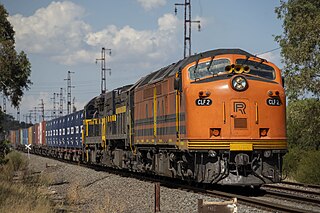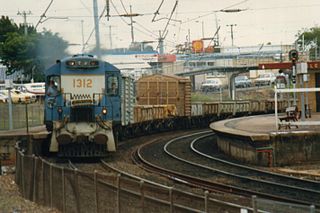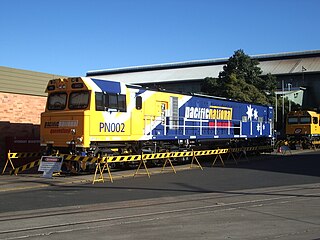Related Research Articles

The EMD G8 is a model of diesel-electric locomotive of which 382 were built between 1954 and 1965 for both export and domestic use. They were built by both Electro-Motive Division in the United States and by General Motors Diesel Division in Canada for use in ten countries, being equipped to operate on several different track gauges.

The EMD G12 is a class of export locomotive built by GM-EMD, and its Canadian affiliate General Motors Diesel. In addition, Australian licensee Clyde Engineering built ten locomotives for New Zealand in 1957, five for Hong Kong, 23 for Queensland, fourteen for Western Australia and seven for BHP. Australian licensee Commonwealth Engineering also built 42 for Queensland Rail in 1964–1966. Many examples were built in the 1950-1960s for railroads around the world.

The 442 class are a class of diesel locomotives built by AE Goodwin and Comeng, Auburn for the New South Wales Department of Railways between 1970 and 1973.

The GT46C is a model of diesel-electric locomotive designed and built by Clyde Engineering using Electro-Motive Diesel components. A number of Australian rail freight operators purchased them from 1997: Westrail as the Q class, FreightLink as the FQ class, and Freight Australia as the single-locomotive V class. As of 2022, all 24 locomotives were owned by Aurizon following its purchase of certain One Rail Australia assets in July 2022.

The T class are a class of diesel locomotives built by Clyde Engineering, Granville for the Victorian Railways between 1955 and 1968.

The CL class is a class of diesel locomotives built by Clyde Engineering, Granville for the Commonwealth Railways in several batches between 1970 and 1972. The class was the last in the world to be built with the Electro-Motive Diesel bulldog nose but differed from previous builds in having a mansard roof.

The GM class are a class of diesel locomotives built by Clyde Engineering, Granville for the Commonwealth Railways in several batches between 1951 and 1967. As of January 2014, some remain in service with Aurizon and Southern Shorthaul Railroad.

The 1300 class were a class of diesel locomotive built by English Electric, Rocklea for Queensland Rail between 1967 and 1972. They were later sold to AN Tasrail.

The L Class are a class of diesel locomotives built by Clyde Engineering, Granville and Eagle Farm, and Commonwealth Engineering, Rocklea for the Western Australian Government Railways between 1967 and 1973.

The J class are a class of diesel locomotives built by Clyde Engineering, Granville, for the Western Australian Government Railways in 1966.

The GT42CU AC is a model of diesel electric locomotives manufactured by EDi Rail, Maryborough between 1999 and 2005 under licence from Electro-Motive Diesel, for use on narrow gauge railways in Queensland.

The 600 class are a class of diesel-electric locomotives manufactured by AE Goodwin, Auburn for the South Australian Railways between 1965 and 1970.

The GT42CU ACe is a model of diesel electric locomotives manufactured by EDi Rail, Maryborough between 2007 and 2013 under licence from Electro-Motive Diesel, for use on narrow gauge railways in Queensland, South Australia and Western Australia.
The BHP Whyalla DH class were a class of diesel locomotives built by Walkers Limited, Maryborough for the BHP's Whyalla Steelworks between 1962 and 1968.

The 500 class were a class of South Australian Railways diesel shunter locomotives built at Islington Railway Workshops between 1964 and 1969.

The WAGR A/AA/AB classes are classes of diesel locomotives built by Clyde Engineering, Granville, New South Wales, Australia, for the Western Australian Government Railways (WAGR) between 1960 and 1969.

The AL class are a class of diesel locomotives built by Clyde Engineering, Rosewater for Australian National in 1976–1977. They were mechanically similar to the CL class but instead of a bulldog nose had two flat ended cabs, similar to the 422 class built for the New South Wales Government Railways in 1969.

The NJ class are a class of diesel locomotive built in 1971 by Clyde Engineering, Granville for the Commonwealth Railways for use on the Central Australia Railway.
The Coffin Bay tramway was a 1,435 mm gauge railway located on the Eyre Peninsula of South Australia. Running for 40 kilometres from Coffin Bay to Billy Lights Point, Port Lincoln it was built and operated by BHP to carry lime sand for steelmaking at Whyalla, Port Kembla and Kwinana. Construction commenced in 1964 with the line opening in 1966.
The BHP Whyalla Tramway is a 1067 mm gauge heavy-haul railway, 112 kilometres long, on the Eyre Peninsula in South Australia. It runs from haematite mines at Iron Monarch, Iron Baron and Iron Duke in the Middleback Range, about 50 kilometres west of Whyalla, to company steelworks at the coastal city of Whyalla. Opened in 1901, it was built by, and until 2000 operated by, BHP. As of 2021 it was owned by Liberty Steel Group and operated on its behalf by rail operator One Rail Australia, which was sold in 2022 to Aurizon.
References
- 1 2 3 4 Oberg, Leon (1984). Locomotives of Australia 1850-1980s. Frenchs Forest: Reed Books. pp. 221, 222, 224. ISBN 0-730100-05-7.
- ↑ "Traffic" Australian Railway Historical Society Bulletin issue 754 August 2000 page 318
- ↑ "Morrison Knudsen Australia and the CLPs" Railway Digest June 1994 page 18
- 1 2 3 BHP / Onesteel / Arrium Whyalla Diesel Locomotives Minnipa Siding
- ↑ DE Class (BHP Whyalla) Railpage
- ↑ 1300 Class (ARG) Railpage
- ↑ T Class (T414) Railpage